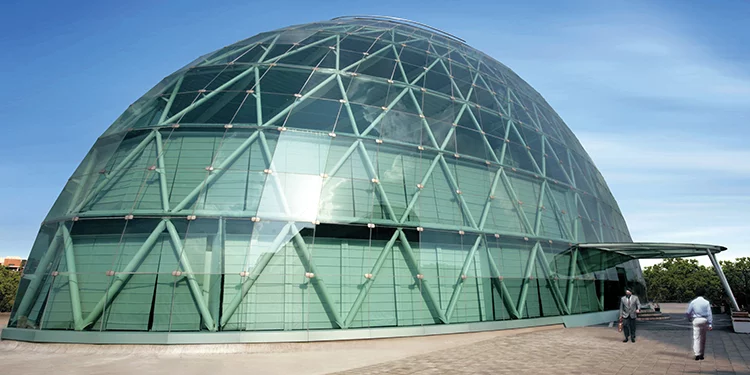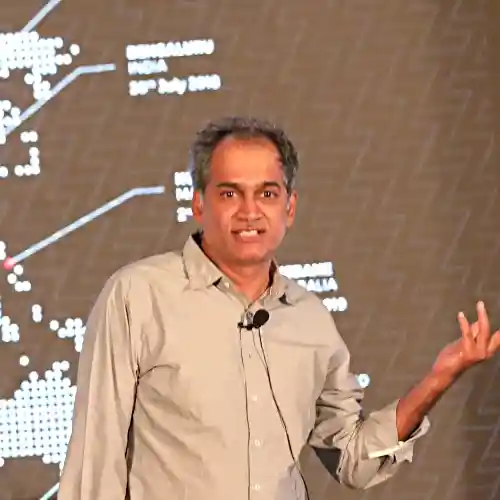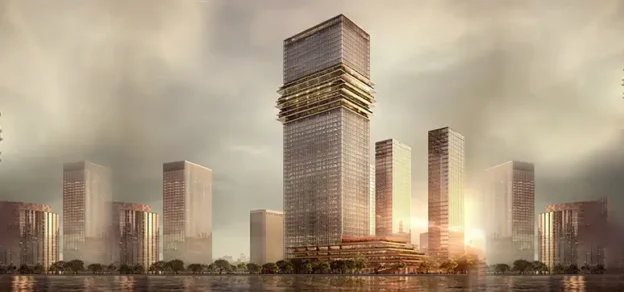Having a glance at monotonous urban spaces at the end of 20th century, we propose a solution which maximizes the possibilities of the human body and spirit and create a chance to energize life in the fullest sense. We propose a comprehensive design that shapes up a place and its environment towards the intangible senses of a human. It is a monumental task to penetrate the city using this approach, yet we desire to find solutions through our designs.
Concurrently, we were working with glass – a material strongly discouraged in use for construction practices as it is not very conducive to the Indian climate. But, with the appropriate, skill technology and knowledge, we were able to blend the use of glass as a construction material in our designs through accurate positioning and use of the appropriate type of glass. Combining the use of glass and fabric, we were able to reproduce dramatic designs that beautifully displayed the innocent play of light and shadow within a building.
The Infosys Ellipsoid
Hinjwadi, Pune
Bringing the 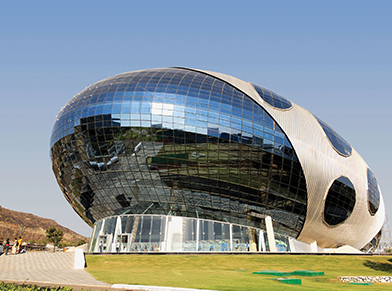 architect’s dream into reality with structural ingenuity and finesse is the bottom line of every brief that an architectural engineering firm deals with. The design for The Infosys Ellipsoid was especially challenging for the futuristic concept developed by Architect Hafeez Contractor for Infosys at Hinjwadi, Pune. The concept having been realised by Construction Catalysers and the building is all set to become an icon reflecting the pride of all involved in its creation. It is a structure embodying the spirit of its users who are people working in the field of computers and software dealing with cutting edge technology; a structure which understands this technology and speaks a similar hi-tech language.
architect’s dream into reality with structural ingenuity and finesse is the bottom line of every brief that an architectural engineering firm deals with. The design for The Infosys Ellipsoid was especially challenging for the futuristic concept developed by Architect Hafeez Contractor for Infosys at Hinjwadi, Pune. The concept having been realised by Construction Catalysers and the building is all set to become an icon reflecting the pride of all involved in its creation. It is a structure embodying the spirit of its users who are people working in the field of computers and software dealing with cutting edge technology; a structure which understands this technology and speaks a similar hi-tech language.
The internal built form consists of 1, 50,000 sq ft of usable floor space on five floors, designed to provide an environment conducive to the software development activity. This structure, with an elliptical footprint, is a conventional structure of reinforced cement concrete and brickwork. It houses the workspaces, offices, meeting rooms, other ancillary areas and services.
The uniqueness of the design lies in the enclosing shell created out of steel, glass and aluminium cladding. Doing away with conventional walls,windows or curtain walling, a gigantic enclosure shelters the entire internal structure. The volume enclosed by this shell is whole and continuous unlike that of a conventional building. The complete structure of the shell stands away and apart from the support system of the internal structure and has a separate structural system of its own.
The enveloping shell has a form derived from an ellipsoid. This partially cut ellipsoid measures 105m along its longer axis and 65m along its shorter axis. It rises to height of 35m and is tilted to an angle of 10 degrees. Due to the tilting, one of its ends appears to be buried into the ground and the other is lifted up. The entrance to the building is from under this raised part. The main entrance has a glass curtain wall with a conical surface that is curved and tilted.
The surface of the ellipsoidal shell, due to its doubly curved character, is strong and rigid, despite being lightweight. It employs pre-stressed grid cell geometry and is a remarkable engineering feat achieved by detailed and innovative architectural engineering. The entire shell rests on an elliptical base ring and a Mediterranean main member, which runs along the vertical Snippetsplane along the long axis of the ellipsoid.
The shell is divided into sixteen radial parts and main structural box sections stiffen these parts. The surface of the shell is formed out of a trapezoidal grid. The individual module of the grid is not curved and instead acts as a facet, which forms a part of the whole ellipsoidal surface.
Snippets
Ellipsoidal Building Envelope for Infosys
- Internal built form 1,50,000 sq ft of usable floor space on five floors
Structure
- Elliptical footprint, in a conventional structure of R.C.C. and brickwork including.
- Enclosing shell out of steel, glass and aluminium cladding.
- Gigantic enclosure shelters to the entire internal structure.
- Ellipsoid, measures 105m along its longer axis and 65m along its shorter axis, rises to height of 35 m and tilted to an angle of 10 degrees.
- One of its ends appears to be buried into the ground and the other is lifted up due to tilting.
- Glass curtain wall with a conical surface.
- Ellipsoidal shell employs pre-stressed grid shell geometry.
- Entire shell rests on an elliptical base ring.
- Shell divided into sixteen radial parts and main structural box sections stiffen these parts.
- Entire shell formed out of a trapezoidal grid.
- Ellipsoidal surface covered with four types of cladding materials
- Main central portion with maximum exposure to the solar region covered with a new composite material “KALZIP”
- Large elliptical cut-outs for cladding to increase the visibility of the inner & outside spaces.
- Aluminium cladding for in solar passivation and energy conservation.
- Opaque cladding glass protected by mesh membrane cladding and horizontal curved fins.
- Clear glass for shaded zone.
The doubly curved ellipsoidal surface is covered with four types of cladding materials. Each of these performs a function relative to its position and in relation to the climatic conditions. The main central portion, which has maximum exposure to the solar region, is covered with a new age material called “KALZIP”. This is an insulated two layer profiled aluminium system with glass wool insulation in between. This cladding has large elliptical cut-outs fitted with high performance doubly glazed units to increase the visibility of the inner floors to the outside world. This glass along with the aluminium cladding aids in solar passivation and energy conservation.
Beyond the limits of the opaque cladding some portion of glass has been protected using mesh membrane cladding and horizontal curved fins. Large portions of clear glass are used in the zone that is below the equator that is in shade for most of the time. This clear glass aids the visual dialogue of the inside spaces to the outside landscape. The hi-tech materials and technology work in unison to support the creation of this ellipsoidal form.
Using structural and architectural engineering skills the concept has been given physical shape. The superbly dynamic aesthetics of the building reflect honestly the state of the art construction techniques and functional values of the design .The result is a superbly futuristic structure which will stand as a landmark for times to come.
| Quick Facts | |
| Project | Ellipsoidal Building Envelope for Infosys |
| Location | Pune |
| Client | Infosys, Pune |
| Architect | Hafeez Contractor, Mumbai |
| Other Consultants: | |
| Architectural Engineering | Construction Catalysers, Pune |
| Manufacturing & Installation | Construction Catalysers, Pune |
| Structural Verification | Sterling Group |
| Civil Work | Sobha Constructions |
| KALZIP | ACP Cladding |
| Materials used for façade | Steel, Glass, Membrane |
| Commencement Date | December 2004 |
| Completion Date | June 2006 |
| Area | 14020 sqm |
| Cost | 8.0 cr |
Sahara Mall, Gurgaon
The surface development for this project has been inspired from sunflower seed pattern. All the glass panels are flexed to achieve free flowing membrane effect where glass is structurally active. 3 way pre-stressed cable-net, curves in two directions, supports vastly varying glass panels. The cable net with the glass curves against gravity.
Kudal Temple Dome,
Kanakwali, Konkan, Maharashtra
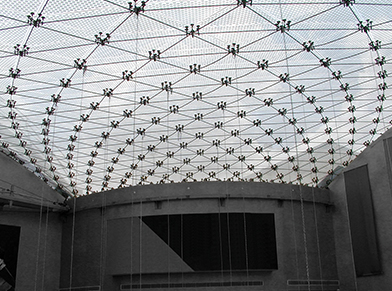 The use of glass purely as a cladding and as a structural element induced a reaction of awe and wonder in the viewer. It was a breakthrough when the firm created a shrine area for a temple using only glass as cladding and allowing sunlight to penetrate the glass that created an unearthly play of light bestowing the temple with a divine semblance.
The use of glass purely as a cladding and as a structural element induced a reaction of awe and wonder in the viewer. It was a breakthrough when the firm created a shrine area for a temple using only glass as cladding and allowing sunlight to penetrate the glass that created an unearthly play of light bestowing the temple with a divine semblance.
i-Lab, Hyderabad
The dia-grid shell is clad with hard-coated glass that ensures a high level of visual comfort, which also also allows a good level of reflection-free sunlight. The central portion of the building at the fifth floor, which is the roof of the board room, is covered with water resistant composite construction that reflects partial direct sunlight.
Nasik Engineering College
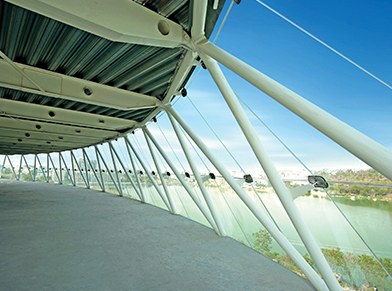
A library building with glass façade looking east – For the rising sun. The spacial architectural space represents openness, an unending curiosity, a place for open, free and unhindered interaction and debate. Further the library of an Engineering College should represent the spirit of engineering, display immaculate structural design and motivate engineering students to create unprecedented feats of Engineering and excel.
Bhopal Airport
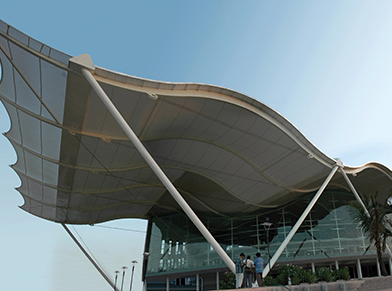
The total design concept is based on advance engineering analytical & digital technique for free flowing light weight shell roof supported on sleek steel columns. The large span glass skylights at required locations makes the roof very elegant and one of its kind. The shell steel structure with imported metal sheets and two huge skylights makes the spaces underneath lively. The entire roof is supported on minimum steel pyramidal columns to create large barrier free volume.
Entrance Canopy: The canopy is of glass and supported with steel members and spiders. The entrance to the building is very imposing and glamorous.
Quest Mall, Kolkata
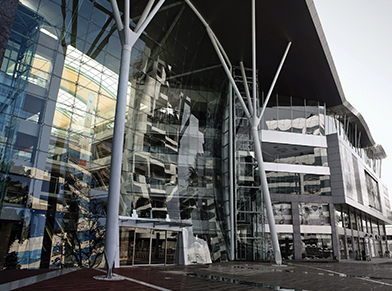
The Glass floors at Quest Mall are a symphony in opaque and transparence, dense & sparse, reflection & illusion. The harmony of materials is achieved with multilayer safety glass within-built ceramic fret work and innovative concept of structure of cable stiffened spatial frame work. As glass floor needs rigid supporting structure, hybrid cable stiffened spatial frame work makes supporting structure sleek and aesthetically pleasing. It allso enhances transparency of glass.
